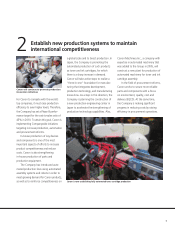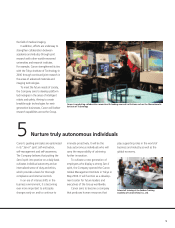Canon 2006 Annual Report Download - page 19
Download and view the complete annual report
Please find page 19 of the 2006 Canon annual report below. You can navigate through the pages in the report by either clicking on the pages listed below, or by using the keyword search tool below to find specific information within the annual report.
17
following five “imaging engines,” a group of technolo-
gies that support Canon product businesses.
1. Image Capturing Engines
2. Electrophotographic Engines
3. Inkjet Engines
4. Photolithographic Engines
5. Display Engines
These engines support product performance and
are the source of Canon’s competitive advantage.
Canon continues to cultivate these engines and explore
the fusion of various technologies, which in turn leads
to the development of key devices and innovative
product features.
An example of an Image Capturing Engine is the
DIGIC imaging processor. In 2006, DIGIC III was intro-
duced with advanced Face Detection Technology that
properly adjusts focus and exposure based on the
detection of people’s faces. Canon has also developed
a new HD CMOS sensor for video camcorders that
enables the high-speed reading of images in full HD
(1,920 x 1,080 pixels).
Canon believes that shared-platform technolo-
gies are vital for accelerating and reinforcing product
development. The Company has established its
unique color management technology that unifies
color reproduction for Canon input and output
products. In addition, Canon is proceeding further
with its advanced color management system, called
“Kyuanos.” Part of this technology has been incor-
porated into Windows Vista™*.
In addition to reinforcing its measuring, analysis
and simulation technologies, Canon uses 3D-CAD
systems to shorten product-development times and to
reduce trial times and costs.
Canon’s color management
technology allows for
consistent color
reproduction in both input
and output devices
3D-CAD design systems have enabled fewer prototypes, shorter
development times and effective information sharing
*Windows Vista is a trademark of Microsoft Corporation.
























